
Learning crochet is as easy as... NexStitch Crochet Articles
NexStitch Crochet Articles Get Hooked on Style! © 2006 NexStitch™ Learning crochet is as easy as... Check out our stylish, step-by-step crochet patterns complete with photo tutorials and links to free online crochet stitch guides for additional assistance. 1. Grasp proper holding techniques 2. Our patterns include multiple, full-color photographs from various angles, helping you get a better sense of the project you are creating. Directions are written clearly with tutorial photos which support the pattern text. Master all the basic stitches 3. Learn to read patterns Make your own gear! In addition, every pattern includes crochet symbol charts, schematics, and stitch diagrams, making it easier to understand. Amie Hirtes Founder/Designer Check us out online at www.nexstitch.com Crochet Articles, Patterns, and Video Tutorial Guides NexStitch Crochet Articles Get Hooked on Style! © 2006 NexStitch™ Detour! Turning and Beginning New Rows in Crochet Now that you have met some of the members of the 'Crochet Family' (single, double, treble etc.), the next step is knowing what to do at the end of a row. You will need to create one or more chain stitches at the end of the row (called a "turning chain"), as this will give some height for you to start a new row. "How many stitches?" you ask. Here's a simple chart for guidance: single crochet: 1 stitch stitch half double crochet: 2 stitches stitches double crochet: 2 or 3 stitches * treble crochet: 3 or 4 stitches* double treble crochet: 4 or 5 stitches* *some patterns will vary The next step is to turn your work horizontally, just like you would turn the page of a book. Some people turn left to right (left-handed crocheters), others turn right to left (right-handed crocheters). There is no one right way, just as long as you are consistent in your turning methods throughout your work. Similarly, some pattern directions ask that you turn first and chain second. Again, there's no one right way, just as long as you chain and turn, or turn and chain, you'll be OK. [The only exception to that rule is if you are asked to slip stitch (slip st) in the new row, which means you won't be chaining.] Garment Turning (step 1) So now that you know you have to chain for height and turn your work, the final step here is to understand the two different ways you can begin a new row. Using the double crochet stitch as an example, let's look at these two different methods and compare how each is beneficial. Garment Turning The first method involves chaining the appropriate amount for height (1), turning the work horizontally, and placing a stitch in the first stitch of the new row. After completing a row of stitches, make sure to always place a stitch in the last stitch while skip- ping the turning chain (2). Garment turning works well for clothing because it assures the crocheter that the pattern will line up from one seam to another. Garment Turning (step 2) Blanket Turning The second method for beginning a row will give a clean edge to any work. It's great for scarves, blankets, table mats, and rugs which are square or rectangular. For this method, chain the necessary amount of stitches (1), and turn. That turning chain will count as the first stitch in the new row. So, skip the first stitch, and continue stitching across. When you get to the end of the row, place a stitch in the turning chain. That will count as the last stitch in the row (2). Blanket Turning (step 1) Practice turning using every member of the 'Crochet Family' so you are more comfortable with it. Decide what your personal preferences are for how many stitches should comprise that turning chain. Once you have a good understanding and feel for turning your work, take a look at some more creative places to make stitches. Blanket Turning (step 2) Check us out online at www.nexstitch.com Crochet Articles, Patterns, and Video Tutorial Guides
© Copyright 2025












